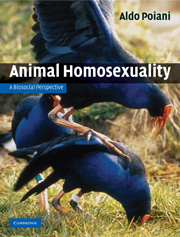Book contents
- Frontmatter
- Dedication
- Contents
- Contributors
- Acknowledgements
- Preface
- 1 Animal homosexuality in evolutionary perspective
- 2 The comparative study of homosexual behaviour
- 3 Genetics of homosexuality
- 4 Ontogenetic processes
- 5 The endocrine and nervous systems: a network of causality for homosexual behaviour
- 6 Immunology and homosexuality
- 7 Sexual segregation effects
- 8 The social, life history and ecological theatres of animal homosexual behaviour
- 9 Homosexual behaviour in primates
- 10 A Biosocial Model for the evolution and maintenance of homosexual behaviour in birds and mammals
- Appendix 1 Glossary
- Appendix 2 Predictions of the Synthetic Reproductive Skew Model of Homosexuality and results obtained in the comparative tests of the model carried out in birds and mammals
- Appendix 3 Comments on further results of comparative analyses of independent contrasts reported in the full correlation matrices of birds and mammals
- References
- Index
- Plates
4 - Ontogenetic processes
Published online by Cambridge University Press: 05 July 2014
- Frontmatter
- Dedication
- Contents
- Contributors
- Acknowledgements
- Preface
- 1 Animal homosexuality in evolutionary perspective
- 2 The comparative study of homosexual behaviour
- 3 Genetics of homosexuality
- 4 Ontogenetic processes
- 5 The endocrine and nervous systems: a network of causality for homosexual behaviour
- 6 Immunology and homosexuality
- 7 Sexual segregation effects
- 8 The social, life history and ecological theatres of animal homosexual behaviour
- 9 Homosexual behaviour in primates
- 10 A Biosocial Model for the evolution and maintenance of homosexual behaviour in birds and mammals
- Appendix 1 Glossary
- Appendix 2 Predictions of the Synthetic Reproductive Skew Model of Homosexuality and results obtained in the comparative tests of the model carried out in birds and mammals
- Appendix 3 Comments on further results of comparative analyses of independent contrasts reported in the full correlation matrices of birds and mammals
- References
- Index
- Plates
Summary
The events occurring at the very early stages of development are of key importance for the future of the individual, as they can have significant consequences later in life. As soon as an ovum is fertilised, the zygote begins a developmental journey known as ontogeny that will take the organism through various phases of growth and change. Understanding the genetic and also the non-genetic factors, both internal to the individual and environmental, that affect such ontogeny is critical to the understanding of the how, when and why homosexuality may be expressed. This chapter mainly focuses on the effects of events occurring in the early developmental stages of a mammal or a bird: from gestation (pre-laying and incubation in birds) to attainment of sexual maturity. However, additional analyses of early developmental effects, such as human syndromes specifically involving endocrine mechanisms, prenatal immune processes and others, will be carried out in Chapters 5 and 6, where the adult stage of the individual will be also considered.
The importance of early events affecting the development of sexual behaviour and sexual orientation has been recognised by students of both human psychology (e.g. Freud 1905) and animal behaviour (e.g. Tinbergen 1963; Lorenz 1970) since the late nineteenth and early twentieth centuries. As a result of the accumulated knowledge on the development of sexuality that occurred especially during the first half of the twentieth century, two major views confronted each other in the 1960s and 1970s that exemplify the two broad schools of thought on the ontogeny of sexuality that somehow remain in place even today: the ‘psychosexual sexuality-at-birth’ (PSAB) and the ‘psychosexual neutrality-at-birth’ (PNAB) theories (Diamond 1965). In the truly manicheistic or polar fashion typical of some scientific debates, the role of specific genetic influences on the development of sexual orientation (i.e. the ‘nature’ pole of the debate) was minimised by supporters of the PNAB theory (e.g. Money 1988; Money & Ehrhardt 1996, but see especially John Money and Anke Ehrhardt’s earlier works: Money & Ehrhardt 1971), whereas proponents of the PSAB theory undervalued the role of learning processes (i.e. the ‘nurture’ pole) while emphasising genetically predisposed tendencies to develop a specific sexual orientation (Diamond 1965).
- Type
- Chapter
- Information
- Animal HomosexualityA Biosocial Perspective, pp. 97 - 158Publisher: Cambridge University PressPrint publication year: 2010

